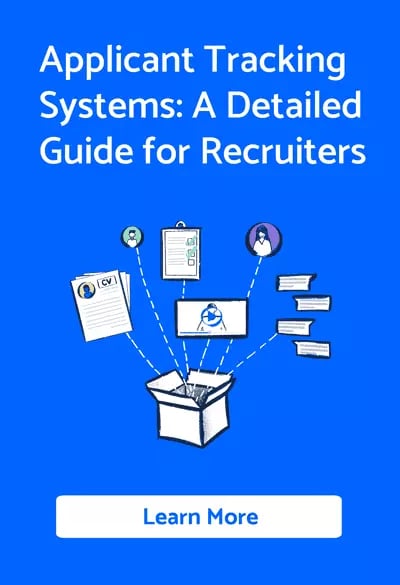In the ever-competitive world of talent acquisition, more than the traditional methods of spreadsheets and email-based recruitment processes is required to attract and retain top talent.
A recent Deloitte study found that organisations with effective talent acquisition strategies experience a 22% higher return on investment.
By embracing modern, data-driven tools and strategies, you can revitalise your recruitment process and significantly improve your organisation's performance.
This article will explore innovative approaches and data-driven strategies that can help you transform your hiring process and leave the constraints of spreadsheets behind.
1. Embrace the Power of Applicant Tracking Systems (ATS)
The Benefits of an ATS
A survey by Capterra found that 94% of recruiters and hiring professionals believe that using an ATS has improved their hiring process. Adopting an ATS allows you to centralise candidate information, automate routine tasks, and enhance collaboration among your hiring team.
Research by ClearCompany indicates that companies that use an ATS reduce their time-to-hire by 32%, improve the quality of their hires by 38%, and achieve a 27% faster applicant screening process.
Choosing the Right ATS
Selecting the right ATS for your organisation involves considering factors such as ease of use, integration capabilities, scalability, and customisation options. Evaluating potential systems based on these factors is essential to ensure that the chosen ATS will meet your organisation's specific needs and help you achieve your recruitment goals.
Streamlining Onboarding with an ATS
An effective ATS can also streamline the onboarding process by automating paperwork, background checks, and orientation scheduling tasks. Research by Glassdoor has shown that organisations with a strong onboarding process can improve new hire retention by 82% and increase productivity by over 70%.
Here's some useful resources:
- 9 Reasons Why You Need To Use An ATS [Not Spreadsheets]
- How To Transition From Spreadsheets To An ATS [8 Quick Steps]
- [GoHire vs Spreadsheets & Email [8 Key Benefits]
2. Leverage Social Media and Professional Networks
The Power of Social Recruiting
A recent report found that 92% of recruiters use social media in their recruitment efforts.
You can target specific industries, skill sets, and locations using social media platforms and professional networks like LinkedIn, broadening your talent pool and connecting with potential candidates more interactively.
A Society for Human Resource Management (SHRM) study found that 84% of organisations use social media for recruitment, with 82% reporting improved candidate quality.
Building a Strong Employer Brand on Social Media
To maximise the effectiveness of social recruiting, building a strong employer brand on social media platforms is essential.
This can be achieved by sharing engaging content, showcasing company culture, and highlighting employee success stories. A LinkedIn study revealed that 75% of job seekers consider an employer's brand before applying, emphasising the importance of a strong employer brand in attracting top talent.
Engaging Passive Candidates through Social Media
Social media platforms also effectively engage passive candidates who may need to actively seek new opportunities.
By establishing a presence in relevant industry groups, sharing job postings, and connecting with potential candidates, you can tap into a vast pool of talent that may not be accessible through traditional recruitment methods.
3. Implement a Structured Interview Process
The Importance of Structured Interviews
A Society for Human Resource Management (SHRM) study found that structured interviews can be up to twice as effective as unstructured interviews in predicting job performance.
By adopting a structured interview process, you can gather consistent, comparable data on candidates, reduce bias, and make more informed hiring decisions.
Furthermore, research by Glassdoor showed that structured interviews are 81% more likely to identify high-quality candidates.
Developing a Structured Interview Framework
To implement a structured interview process, developing a framework that includes a standard set of interview questions, rating criteria, and evaluation methods is essential.
This framework should be designed to assess the specific skills, experience, and cultural fit required for each role. Additionally, training your hiring team on the structured interview process is essential to ensure consistency and reduce the potential for bias.
Leveraging Behavioral and Situational Interview Questions
Incorporating behavioural and situational interview questions into your structured interview process can help you gain deeper insights into a candidate's past experiences and problem-solving abilities.
These questions encourage candidates to share specific examples of how they have handled various situations or challenges, providing valuable information that can inform your hiring decisions.
4. Harness the Potential of Video Interviewing Platforms
The Benefits of Video Interviews
The Aberdeen Group found that companies using video interviews shortened their time-to-hire by 58% and experienced a 47% increase in candidate quality.
By conducting interviews on Zoom or Microsoft Teams, you can streamline the interview process, improve scheduling flexibility, and easily compare candidates.
A study by Korn Ferry revealed that 74% of hiring managers believe that video interviews are as practical, if not more effective, than in-person interviews.
Tips for Conducting Effective Video Interviews
To ensure that video interviews are both engaging and informative, it is important to establish a clear structure, prepare relevant questions, and create a comfortable environment for both the interviewer and the candidate.
This may involve testing your technology beforehand, minimising distractions, and setting aside sufficient time for the interview. Additionally, providing candidates with guidance on what to expect during the video interview can help them feel more prepared and confident.
Recording and Evaluating Video Interviews
Many video interviewing platforms offer recording capabilities, allowing you to review and compare interviews at a later time.
By recording interviews, you can share them with other team members for evaluation, ensuring that hiring decisions are based on collective input and reducing the potential for bias.
5. Collaborate Through Centralised Communication Channels
The Value of Centralised Communication in Recruitment
Establishing a centralised communication channel, such as Slack or Microsoft Teams, reduces the risk of miscommunication and ensures your hiring team remains aligned throughout the recruitment process.
A McKinsey survey found that using social collaboration tools can improve productivity by 20-25% within organisations.
Implementing a Centralised Communication Channel
To implement a centralised communication channel for your recruitment process, create dedicated channels or groups for each open position and invite relevant team members to join.
This will allow your team to share candidate information, updates, and feedback in one centralised location, fostering collaboration and promoting transparency.
Integrating Communication Channels with Other Recruitment Tools
Many communication platforms can be integrated with other recruitment tools, such as an ATS or project management software, further streamlining the hiring process.
These integrations allow you to automate notifications, synchronise data, and ensure all relevant information is accessible in one place.
6. Focus on Employer Branding
The Impact of Employer Branding on Recruitment
A recent study by Glassdoor found that 69% of job seekers are likely to apply for a job if the employer actively manages its employer brand.
Investing in your organisation's employer branding and promoting your company culture can attract top talent and reduce your reliance on spreadsheets for tracking applicants.
A LinkedIn survey revealed that a strong employer brand can reduce cost-per-hire by 50% and increase the likelihood of attracting passive candidates by 120%.
Strategies for Strengthening Your Employer Brand
To build a strong employer brand, showcase your organisation's values, culture, and employee experiences.
This can be achieved through various strategies, including sharing engaging content on social media, highlighting employee success stories, and providing a transparent and informative careers page on your website. By consistently communicating your employer brand, you can differentiate your organisation from competitors and attract top talent.
Measuring the Success of Your Employer Branding Efforts
To gauge the effectiveness of your employer branding efforts, tracking key performance indicators (KPIs) such as application rates, time-to-hire, and employee retention is essential.
By monitoring these metrics, you can identify areas for improvement and refine your strategies to maximise your employer branding impact.
7. Utilise Data-Driven Recruitment Strategies
The Importance of Data-Driven Recruitment
Data-driven recruitment strategies enable you to make informed decisions based on insights and trends.
According to a 2020 LinkedIn report, 73% of talent professionals believe that data-driven recruiting is a top priority.
By leveraging data analytics, you can optimise your recruitment process, identify skill gaps, and forecast hiring needs.
Implementing Data-Driven Recruitment Techniques
Collect relevant data on your organisation's hiring process to implement data-driven recruitment techniques.
This may include time-to-hire, cost-per-hire, candidate source effectiveness, and employee turnover.
By analysing this data, you can identify trends, pinpoint inefficiencies, and develop targeted strategies to improve your recruitment outcomes.
Leveraging Predictive Analytics for Recruitment
Predictive analytics can be a powerful tool in data-driven recruitment, enabling you to forecast future hiring needs, identify potential skill gaps, and proactively address workforce challenges.
By incorporating predictive analytics into your recruitment strategy, you can stay ahead of market trends and ensure your organisation is well-equipped to meet future demands.
Let's wrap up what we've learned...
The future of recruitment lies in embracing cutting-edge tools, strategies, and data-driven approaches to revolutionise how you attract, engage, and retain top talent.
A LinkedIn study found that companies with strong talent brand experience a 50% reduction in cost-per-hire and a 28% decrease in employee turnover.
By implementing an Applicant Tracking System, leveraging social media, adopting project management tools, and focusing on structured interviews, video platforms, employer branding, and data analytics, you can pave the way for a more efficient, effective, and engaging hiring process.
It's time to bid farewell to spreadsheets and welcome a new era of recruitment that empowers your organisation to excel in the competitive talent landscape.





